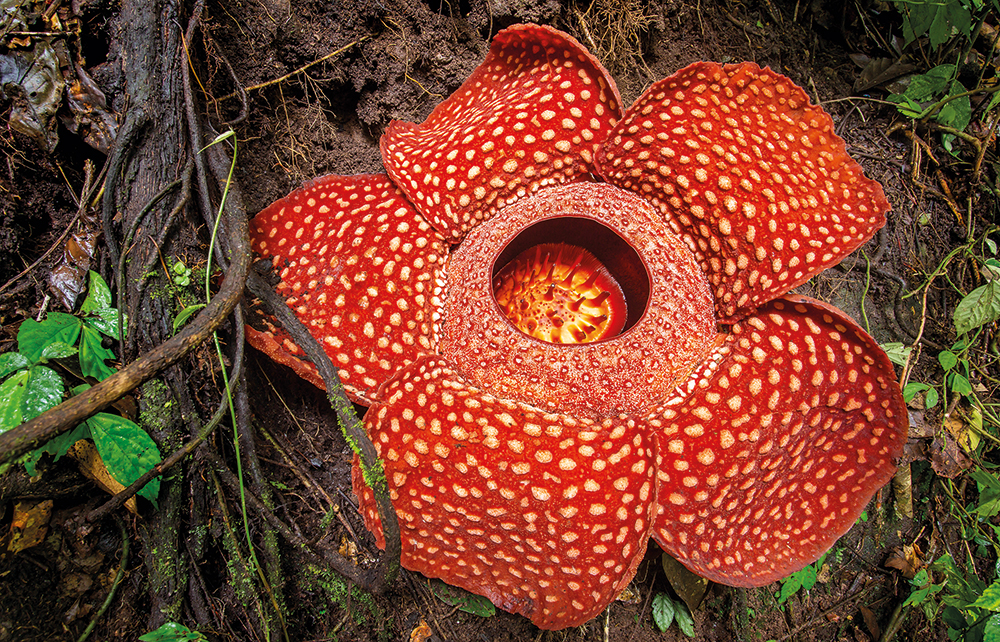Plants regularly lose out to animals in the charisma stakes. In Pathless Forest, Chris Thorogood seeks to promote a new face of Southeast Asian conservation: Rafflesia, one of the strangest and most gruesome plants on the planet.
Rafflesia is a parasitic plant, deriving everything that it needs from its host, spending most of its life as a microscopic thread hidden inside a vine. It cannot photo-synthesise and survives without roots, stem or leaves. Once every few years, buds emerge which take nine months to mature. Finally open, the enormous five-lobed flowers resemble slabs of bloody, white-flecked meat. Most spectacular of all is Rafflesia arnoldii, the largest single flower in the world, a metre across, weighing up to 10kg. And then there’s the smell. The flower not only emits the scent of rotting flesh; it heats up to spread the odour, attracting pollinating carrion flies (hence its common name, ‘corpse flower’). After five days of stinking, fly-blown glory, the flower subsides into a mass of black slime.
There are 42 known species of Rafflesia across Southeast Asia, mainly in the Philippines, Indonesia and Malaysia. Each species occurs on only one island, and populations are confined to specific forest locations, some very remote. Because of their rarity and unpredictable flowering, not every Rafflesia species has been fully described by botanists. Increasingly, their forest habitats are threatened by logging, agriculture and encroaching coffee and oil palm plantations. With such a high risk of extinction, botanists and foresters across the region are co-ordinating efforts to describe Rafflesia, encourage responsible ecotourism and involve indigenous people in protecting the plant.
After five days of stinking, fly-blown glory, the flower subsides into a mass of black slime
Among its British champions is Thorogood, the deputy director and head of science at Oxford Botanic Garden. In addition to his academic work, he writes and illustrates books on exotic plants and appears on Gardeners’ Question Time. In Pathless Forest, he frames a recent trip to the Philippines, Java and Sumatra as a tale of adventure: ‘We’re about to step off the map, into a phantom forest ruled by snakes, spiders and tropical diseases.’ Following guides down machete-hacked trails, he and his fellow botanists crawl through the undergrowth, wade through rivers, get covered in leeches and are attacked by stinging trees as they search for Rafflesia species in their brief flowering moment.
A man in the grip of an obsession, Thorogood believes that he has a calling to save the forest and the flower. This call is interpreted quite literally by endowing Rafflesia with the gift of speech. The main narrative is interrupted by short sections, headed with an ornamental Rafflesia design, that give voice to the plant (‘Out of the warm wetness my flower expands like rising dough’). Other passages, announced by a leaf emblem, appear to be messages from an indigenous forester, urgently summoning ‘Mr Chris’ to come, before it is too late, to tell people that the forest is sick. When Thorogood finally encounters a rare Rafflesia, he intuits a connection between himself, the plant and the forest: ‘I can sense sap rising through the vines beneath my fingers, like arteries: life blood to the forest.’
At other times, Thorogood switches to engaging lecturer mode to explain, for instance, current theories of gigantism. DNA sequencing has revealed that Rafflesia’s ancestors belonged to the tiny-flowered spurge family. ‘Perhaps gigantism evolved in response to fly pollination,’ suggests Thorogood. Since the flower mimics rotting meat, the larger the corpse, the greater the number of flies. With its astonishing 80-fold flower expansion, Rafflesia demonstrates ‘one of the most dramatic examples of size evolution ever reported’.
Thorogood also weaves memoir into the mix. He dates his fascination with Rafflesia back to childhood books of plant wonders, recalling the papier-mâché corpse flower he modelled to transform a corner of the neighbouring cemetery into an imaginary rain forest. Then there’s the decade of happy field trips with students to southern Portugal: ‘Like a goatherd, I belonged to the place, could identify all of its plants by their smell alone.’ With his finely tuned nose, he learns to discriminate ‘like a sommelier’ between the stinks of various Rafflesia species: bad chicken; cat’s breath; blocked drains; sewage.
At Bogor Botanic Garden in Java, Thorogood and his colleagues learn techniques of grafting Rafflesia-infected vine roots from the ‘wizard’ himself, Mr Ngatari, the only living horticulturist to have successfully propagated the plant. The book’s final pages see the team of botanists return to the Philippines and painstakingly attempt to replicate the grafting operation. Whether the procedure will prove successful remains to be seen. But in his flamboyant account, Thorogood has produced a book as highly coloured as the plant itself. It will surely raise the profile of Rafflesia from stinking corpse flower to icon of Southeast Asian plant conservation.






Comments